Principal Growth Fund Invest Online

The Principal Growth Fund has given excellent returns in the last three years after a superb turnaround in performance. This diversified equity fund was underperforming for many years but a major portfolio reshuffle in 2012 saw the funds outperforming its benchmark index and most of its peers in the last three years. The chart below shows the annual returns of Principal Growth Fund (growth option) and the benchmark index, S&P BSE 200 over the last ten years from 2004 to 2013.
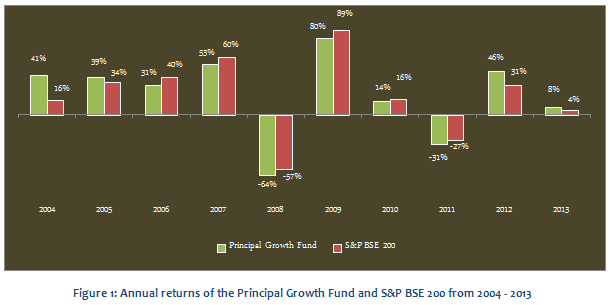
We can see that the Principal Growth fund was underperforming relative to its benchmark index, the BSE 200 till 2012. But after its turnaround in 2012, the fund has outperformed the benchmark index and the diversified equity funds category on a consistent basis. The chart below shows the trailing annualized returns of the Principal Growth Fund (growth option) and the diversified equity funds category, over the last 1 year, 3 years and 5 years time periods. Returns are based on NAVs as on October 9 2014.
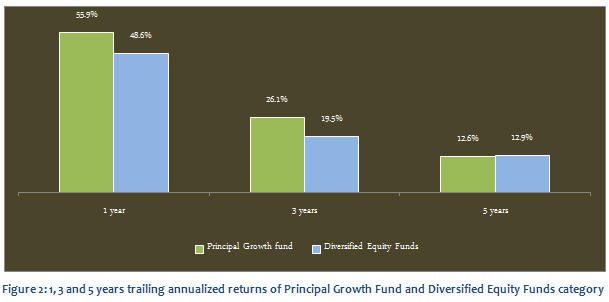
Fund Overview
The Principal Growth Fund was launched in October 2010. It is a diversified equity funds which invests in a mix of large cap and midcap stocks. The fund has Rs 309 crores of assets under management. The expense ratio of the fund is 2.55%. The manager of this fund is P V K Mohan. CRISIL has ranked this fund, a "very good" performer (Rank 1). The fund is suitable for making investments towards long term financial goals, like retirement planning, children's education, wealth creation etc. The fund is open for both growth and dividend options.
Portfolio Composition
The fund has a large cap bias with a growth oriented focus. Large cap stocks comprise 65% of the portfolio, while small and midcap stocks comprise 35%. The portfolio is overweight on cyclical sectors like BFSI, Automobile & Auto Ancillaries, Oil and Gas, Metals etc. To balance its exposure to cyclical sector, the portfolio also has allocations to defensive sectors. IT, FMCG and Pharmaceuticals, comprise nearly 23% of the portfolio holdings. In a long term secular bull market cyclical sectors are expected to do well. As such, the Principal Growth Fund has the potential to deliver good returns in the medium to long term. The portfolio is very well diversified in terms of company concentration. The top 5 companies in the fund portfolio, ICICI Bank, ITC, Tata Motors, Reliance Industries Limited, and Aurobindo Pharma account for only 21% of the portfolio value. Even the top 10 companies in the fund's portfolio account for less than 35% of the portfolio holdings.
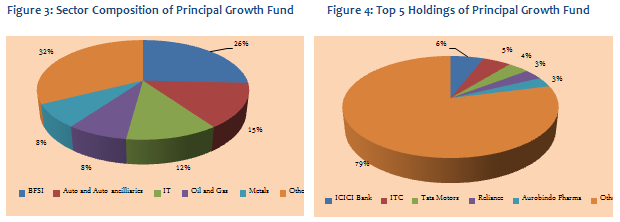
Risk and Return
In terms of risk measures, the annualized standard deviation of monthly returns of the Principal Growth fund is slightly on the higher side, relative to the diversified equity fund category. However, on a risk adjusted returns basis, as measured by Sharpe Ratio, the Principal Growth Fund has outperformed the diversified equity funds category. Sharpe ratio is defined as the ratio of excess return (i.e. difference of return of the fund and risk free return from Government securities) and annualized standard deviation of returns. Higher the Sharpe ratio better is the risk adjusted performance of the fund. See charts below for comparison of volatilities and Sharpe ratios of the Principal Growth Fund and the diversified equity funds category.
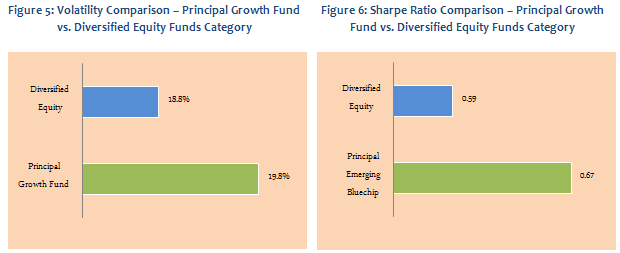
र1 lac lump sum investment in the fund NFO (growth option) would be at a value of nearly र8.8 lacs as on October 9, 2014. The lump sum annualized return since inception is 11%. The return since inception is low due to the past underperformance. However, over the last 3 years the fund gave a return of over 25% annualised. The chart below shows the growth of र1 lac lump sum investment in the Principal Growth Fund (growth option) since inception.
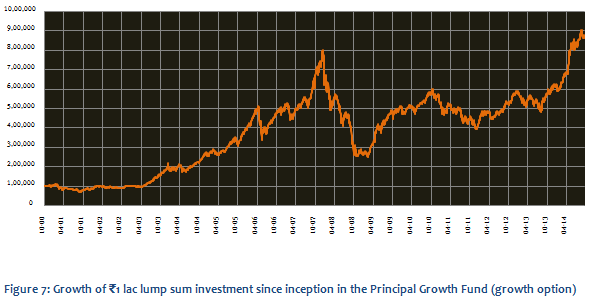
The SIP performance of the Principal Growth Fund since inception is much better than the lump sum performance. The chart below shows the returns since inception of र3000 monthly SIP in the fund (growth option). The SIP date has been assumed to first working day of the month.
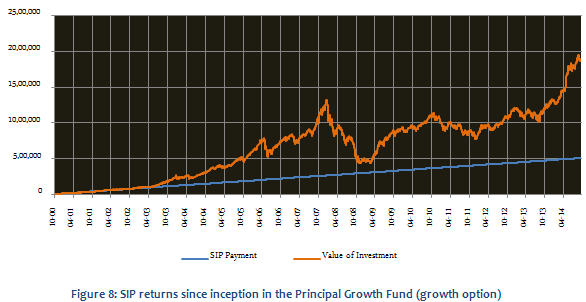
The chart above shows that a monthly SIP of र3000 started at inception of the Principal Growth fund (growth option) would have grown to nearly र18.8 lacs by Sep 26 2014, while the investor would have invested in total only about र5.1 lacs. The SIP return (XIRR) is nearly 18% since inception. The good SIP return of the Principal Growth Fund since inception, despite the past underperformance, underscores the benefits of systematic investing. If the fund is able to sustain its last three years performance, the SIP returns will improve even further in the future.
Conclusion
The Principal Growth Fund has had 3 years of strong performance. This fund has definitely turned around and the outlook for the future is positive. Thus fund is suitable for investors with a long time horizon. Diversified equity funds which invest in a mix of large cap and midcap stocks are ideal for retail investors in the long term, because large cap and midcap stocks outperform one another in different market conditions. One can consider investing in the scheme both through the systematic investment plan (SIP) or lump sum route. Investors should consult with their financial advisors, if Principal Growth Fund is suitable for their investment needs.
Top 10 Tax Saving Mutual Funds to invest in India for 2016
Best 10 ELSS Mutual Funds in india for 2016
1. BNP Paribas Long Term Equity Fund
2. Axis Tax Saver Fund
3. Franklin India TaxShield
4. ICICI Prudential Long Term Equity Fund
5. IDFC Tax Advantage (ELSS) Fund
6. Birla Sun Life Tax Relief 96
7. DSP BlackRock Tax Saver Fund
8. Reliance Tax Saver (ELSS) Fund
9. Religare Tax Plan
10. Birla Sun Life Tax Plan
Invest in Best Performing 2016 Tax Saver Mutual Funds Online
For further information contact Prajna Capital on 94 8300 8300 by leaving a missed call
---------------------------------------------
Leave your comment with mail ID and we will answer them
OR
You can write to us at
PrajnaCapital [at] Gmail [dot] Com
OR
Leave a missed Call on 94 8300 8300
-----------------------------------------------